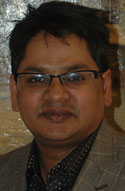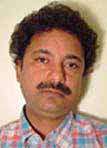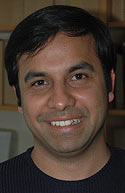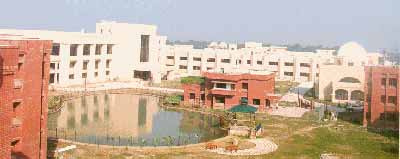SWEDISH SOUTH ASIAN STUDIES NETWORK
Division of Social Medicine, Department of Public Health Sciences, Karolinska Institutet, Stockholm
Other departments/units at Karolinska Institutet Medical University |
Postal address: Karolinska Institutet,
Department of Public Health Sciences, Division of Social Medicine, SE-
171 76 Stockholm, Sweden
Visiting address: Norrbacka, second Floor, Karolinska
University Hospital, Solna
Web page: http://www.phs.ki.se/socmed/index_en.html
Contact person: Associate Professor Bjarne Jansson, phone: +46 (0)8 737 37 92. Director for the Programme of Public Health Sciences
South Asia related research and education at the division:
 Associate
Professor Bjarne Jansson
(photo to the left) is a senior lecturer at the Division of Social
Medicine, and is involved in research on trauma epidemiology including
evaluation of surveillance systems, registry data analysis, implementing
safe community programs, vulnerable groups for injuries, e.g. epilepsy,
stroke, longterm disabilities, child labour and violence in India, social
etiology of injuries, costs of injuries, and a manual for economic evaluation
in safe community practice. Additionally, a project on redistributive
mechanism in social security systems.
Associate
Professor Bjarne Jansson
(photo to the left) is a senior lecturer at the Division of Social
Medicine, and is involved in research on trauma epidemiology including
evaluation of surveillance systems, registry data analysis, implementing
safe community programs, vulnerable groups for injuries, e.g. epilepsy,
stroke, longterm disabilities, child labour and violence in India, social
etiology of injuries, costs of injuries, and a manual for economic evaluation
in safe community practice. Additionally, a project on redistributive
mechanism in social security systems.
He is also Course Director for two partly Internet based
Masters programmes in Public Health Education run at Karolinska
Institutet, ”Master in Health Economics, Including Safety”,
and ”Master in Medical Safety”. More
information on the Masters programmes.
He has in the last years taken an initiative to gather a group of Safety
Economists from Karolinska Institutet as well as Lund University (with
Professor Ulf Gerdtham, Dept.
of Community Medicine), to develop research models and apply them within
this field as well as organising training courses both on location and
on Internet. A very appreciated Manual for Cost Calculations to use level
has raised attention, a model being developed in collaboration between
the Division of Social Medicine and the Dept. of Public Health Sciences,
Division of Epidemiology, Umeå University, and the Dept. of Health
and Environment, Division of Prevention and Epidemiology, Linköping
University.
Associate Professor Fazlur
Rahman has also been connected to the Division. He is Executive Manager for the Centre for Injury Prevention and Research (CIPRB) in Dhaka, Bangladesh. Dr. Rahman has
been working in public health, injury epidemiology and community safety
for more than 15 years. His interests are also injury surveillance and
drowning
prevention specially in low-income country context. He is the Director
of Sherpur Safe Community Programme and Secretary General of Bangladesh
Safe Community Founda tion. He organised the 2nd Asian Regional Conference
at Dhaka, Bangladesh in 2004 and is working as the coordinator of WHO
Affiliated Safe Community Support Centre at ICMH, Dhaka. More
information below.
 Dr. Jahangir
Khan (photo to the right), originally hailing from Bangladesh, defended his doctoral dissertation on ”The impact of social security compensation inequality on earnings distribution due to sickness and disability” at the department on Friday 16 September 2005 (more information about this Swedish related thesis). The faculty opponent was Prof. Espen Bratberg, Dept. of Economics, Bergen University, Norway.
Dr. Jahangir
Khan (photo to the right), originally hailing from Bangladesh, defended his doctoral dissertation on ”The impact of social security compensation inequality on earnings distribution due to sickness and disability” at the department on Friday 16 September 2005 (more information about this Swedish related thesis). The faculty opponent was Prof. Espen Bratberg, Dept. of Economics, Bergen University, Norway.
Jahangir Khan is now working at the Department of Learning, Informatics, Management and Ethics - LIME at Karolinska Institutet. There he is involved in a pilot study to calculate the production cost of pregnancy and puerperium
related healthcare services in Bangladesh and to estimate the difference in mean costs related to
complication in treatment procedures for investigating the possibility of developing the BD-DRG
(Bangladesh diagnostic related groups). The project is carried out in collaboration with Dr. Golam Sarowar, Dr. Emma Medin, and Associate professor Clas
Rehnberg at the same department; and with Dr. Rukhsana Gazi, Dr. Rumana Saifi, Dr. Tracey Koehlmoos, and Dr. Abbas Bhuiyan at the Health
Systems and Economics Unit, ICDDR,B, Dhaka, Bangladesh. On 28 May 2008, Dr. Khan presented a paper titled ”Production Cost of Pregnancy and Puerperium related Health Care Services – a pilot study” in a panel on ”Improving maternal health and infant child survival” at the Sida-funded conference on current Swedish development research titled ”Meeting Global Challenges in Research Cooperation” that was jointly organised by Uppsala University and the Swedish University of Agricultural Sciences (SLU) in Uppsala 27-29 May 2008 (more information about the conference). ![]()
Abstract: Private health care provision is growing in Bangladesh, while the public sector is
underperforming. Benchmarking in pricing in private sector and performance based budgeting in
pubic sector are inevitable for both efficiency and equity in health care. Information about costs
for health care production is essential for planning effective resource allocation in health care
sector. Development of Diagnostic related group (DRG) can contribute for planning budget in
organizational and national levels. Under a planning grant of SIDA, a case study was carried out
in a public hospital in Bangladesh during February-March, 2008.
Data and Method: The data refers to a one-year period (July, 2006 – June 2007) and costs have
been calculated based on extracted patient records. We have used modified form of Step Down
Cost Accounting method as we have taken only one single ward and one diagnostic category for
cost calculation. We have taken into consideration almost all the partial overhead costs that are
contributing to produce the service for each case. Cost items are principally divided into costs for
direct medical care, costs for intermediate care and capitals costs.
Results: Production costs for 156 cases were calculated. Ten principle diagnoses were identified
within pregnancy and puerperium related healthcare services. The highest average cost was
found for abortion and related cases with an average cost of 719 SEK. The most frequent service
in the piloting site, i.e. early pregnancy with hyperemesis costs 425 SEK per case.
Focusing on complication in treatments, separated into management and surgical procedures, we
found that a non-complicated case costs 398 SEK while a complicated one costs 815 SEK for
medical management. Surgical procedure in Caesarian Section costs 635 SEK for non-complication and 824 SEK for complication. Normal Vaginal Delivery cost for 304 SEK and 778
SEK respectively. The average costs for Dilation and Curattage are 298 SEK and 1025 for non-complicated and complicated cases respectively.
Conclusion: Average health care production costs for pregnancy and puerperium related
healthcare services vary across principle diagnoses as well as between complicated and non-complicated medical procedures. For planning an effective and equitable health care servic in
Bangladesh, DRG can be established.
PhD candidate Shahjahan
Khan comes from Dhaka, Bangladesh. He is working on a research
project dealing with ”Injuries in
the garments industry in Bangladesh – epidemiology and prevention”.
 PhD Koustuv Dalal
(photo to the left) is a M.Sc. in Health Economics originally from Kolkata,
India. He has been the course administrator and lecturer of Master of Health
Economics at Karolinska Institutet, but after completing his doctoral dissertation Koustuv Dalal has now left Karolinska Institutet, and is working at the Department of Clinical and Experimental Medicine, Linköping University from 2009.
PhD Koustuv Dalal
(photo to the left) is a M.Sc. in Health Economics originally from Kolkata,
India. He has been the course administrator and lecturer of Master of Health
Economics at Karolinska Institutet, but after completing his doctoral dissertation Koustuv Dalal has now left Karolinska Institutet, and is working at the Department of Clinical and Experimental Medicine, Linköping University from 2009. ![]()
While still at KI, Koustuv received
a prestigious research grant together with Dr. Bjarna Jansson, given by the Swedish Research Council. The research
project was entitled ”Violence in low-income
countries: In search of causes and socio-economic effects”.
In April 2006, Koustuv Dalal won the best scientific paper award of the 8th
World Conference on Injury Prevention and Safety Promotion, held in
Durban, South Africa. It was the largest conference in the
field of injury prevention and safety promotion. Koustuv’s paper
dealt with cost calculation of violence (injury) in developing countries.
Most families in developing countries are dependent on one persons’ income.
If that person is injured then the whole family is affected. Considering
those conditions, in his model Koustuv has introduced six new variables
and negated the traditional concepts of cost calculation of injury, using
by several experts including WHO mannual. Koustuv has tested this model
in India and shown that the traditional system has under-estimated the
cost of injury by about 80%.
 PhD
candidate Sheikh
Muazzam Nasrullah from Pakistan (photo to the right)
completed a Masters Degree of Master of Safety Promotion in 2004 with
a thesis on ”Impact of Unemployment
on cause specific injury mortality – A statistical analysis”.
He is now proceeding with a PhD project, working with Professor Lucie
Laflamme, Director of Research Education at the department,
and with Dr. Junaid Razzak, visiting fellow
at Karolinska Institutet, and Assistant Professor at the Section of Emergency
Medicine, Department of Medicine, Aga Khan University. The latter is Nasrulla’s
supervisor.
PhD
candidate Sheikh
Muazzam Nasrullah from Pakistan (photo to the right)
completed a Masters Degree of Master of Safety Promotion in 2004 with
a thesis on ”Impact of Unemployment
on cause specific injury mortality – A statistical analysis”.
He is now proceeding with a PhD project, working with Professor Lucie
Laflamme, Director of Research Education at the department,
and with Dr. Junaid Razzak, visiting fellow
at Karolinska Institutet, and Assistant Professor at the Section of Emergency
Medicine, Department of Medicine, Aga Khan University. The latter is Nasrulla’s
supervisor.
Junaid Razzak is himself currently a PhD candidate, supervised by Prof. Lucie Laflamme, and will defend his PhD in September 2005. His areas of research includes injury and violence prevention with emphasis on defining the epidemiology of injuries in Pakistan. Besides his position at AKU he is also connected to the Dept. of Emergency Medicine at Emory University School of Medicine, Atlanta, USA, and has been instrumental in starting the Division of Global Emergency Medicine at Yale.
In the first batch of the Masters programme in Safety Promotion, launched in the year 2003/04 other South Asian students also took part either at location in Stockholm or through the Internet. They were graduated in June 2004. Among them were Mohit Aggarwal from India who wrote a thesis on ”Violence committed by adolescents in developed countries: Risk factors and prevention”; and Salim Mahmud Chowdhury from Bangladesh, who wrote a thesis on ”Epidemiological study of injury due to falls among young children in Bangladesh”.
WHO Collaborating Centre on Community Safety Promotion
 The
Division of Social Medicine is involved in an International WHO projct
regarding Centres on Community Safety Promotion. The Safe Communities
concept began its formal existence at the First World Conference on Accident
and Injury Prevention held in Stockholm, Sweden in September 1989 and
at the same time the first agreement on collaboration with the WHO was
signed. The Safe Community initiative differs in comparison to other safety
promotion programs, with the leading role being played by the community
itself. Creative methods of education and environmental change combined
with appropriate legislation and enforcement are important as a starting
point for the safety of a community. No single approach is sufficient
for changing existing accident/injury patterns.
The
Division of Social Medicine is involved in an International WHO projct
regarding Centres on Community Safety Promotion. The Safe Communities
concept began its formal existence at the First World Conference on Accident
and Injury Prevention held in Stockholm, Sweden in September 1989 and
at the same time the first agreement on collaboration with the WHO was
signed. The Safe Community initiative differs in comparison to other safety
promotion programs, with the leading role being played by the community
itself. Creative methods of education and environmental change combined
with appropriate legislation and enforcement are important as a starting
point for the safety of a community. No single approach is sufficient
for changing existing accident/injury patterns.
Affiliated centres have been set up all around the World, with the aim
to promote the Community Safety Approach globally by developing good community
programs for safety, by identifying demonstration programs, making quality
controls and designating them. In South Asia the Institute
of Child and Mother Health (ICMH) in Matuail, Dhaka, Bangladesh
(photo above), is the only affiliated centre so far. More
information on ICMH.
SASNET - Swedish South Asian Studies Network/Lund
University
Address: Scheelevägen 15 D, SE-223 70 Lund, Sweden
Phone: +46 46 222 73 40
Webmaster: Lars Eklund
Last updated
2010-05-21
